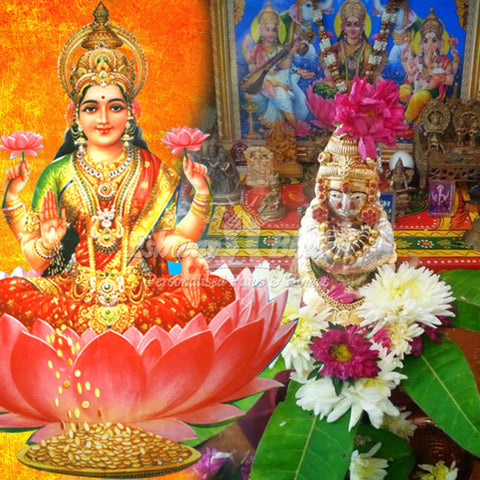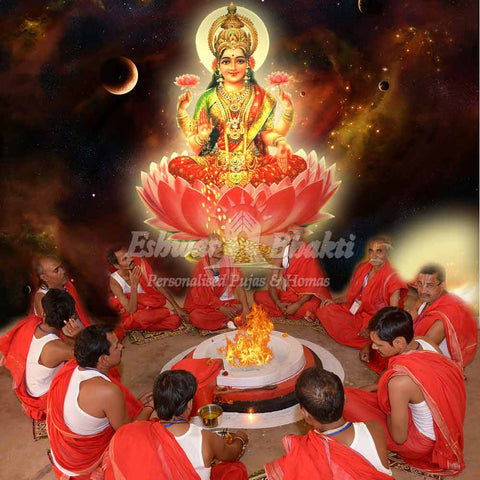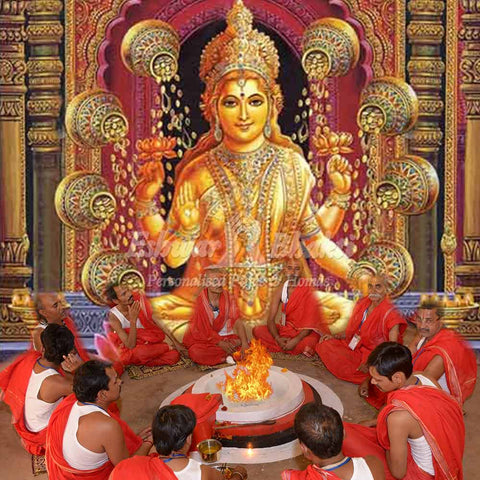Varalakshmi Vrat
Hinduism is a religious belief with countless rituals and traditions. Each of these customs plays a crucial role in our lives. Varalakshmi Vrat is one such festival that devotees of Hinduism continue to celebrate for centuries. Varalakshmi Vrat is akin to Maha Lakshmi Puja we conduct. Here, in this article, we will look at the origin, significance, celebration, and stories related to Varalakshmi Vrat.

We celebrate Varalakshmi Vrat to attain the blessings of Goddess Lakshmi, who is the Goddess of wealth. Hindu men and women take part in these celebrations. However, Hindu women, mostly Sumangalis or married women, conduct Varalakshmi Vrat. Vara is a Sanskrit word, which refers to bonus or reward, and Vrat means fasting. On the day of Varalakshmi Vrat, women undergo fasting to achieve the blessings of Goddess Lakshmi. It is a festival in South India, celebrated mostly in Kerala, Tamil Nadu, Karnataka, Telangana, and Andra Pradesh. Devotees conduct the festival on the second Friday or the Friday before Poornima in the Hindu month of Shravana. It falls in July or August. Varalakshmi Vrat is an auspicious celebration that can bring prosperity, wealth, health, happiness, and satisfaction to our lives.
Legends related to Varalakshmi Vrat: Unlike other festivals, there are not many references to Varalakshmi Vrat in ancient texts and scriptures. However, in Skanda Purana, there is an instance where Lord Shiva explains to Goddess Parvathi about Varalakshmi Vrat. He highlights the relevance and the reason behind its celebration to His beloved consort.
As per the Puranic text, Charumathi, a young woman belonging to Kundinyapura town, was a devotee of Goddess Lakshmi. She prayed to Goddess Lakshmi regularly. One night, when she was sleeping, Goddess Lakshmi appeared in Charumathi's dream. The Goddess asked her to worship Varalakshmi, a form of Goddess Lakshmi, on the second Friday of Shravana month. Once Charumathi discussed with her family about the dream, her family asked her to conduct the prayers. So, she decided to organize it. With her, many other women in her town also participated in the ritual. They performed the recitation of mantras and hymns. In the end, they attained blessings from the Goddess and became prosperous in their lives. The mantra that they chanted during their prayer was:
Padmasana Padmakare, Sarva Lokaika Poojithe
Narayanapriye Devi, Supreetha Bhava Sarvadha
Devotees continue to recite this mantra during the Varalakshmi Vrat to receive the blessings from Goddess Laksmi. In recent days, the popularity of Varalaksmi Vrat has grown immensely.
Significance of Varalaksmi Vrat: As Lord Shiva explains in the Skanda Purana, Varalakshmi Vrat is an auspicious festival. On the day of Varalakshmi Vrat, Goddess Lakshmi takes the form of eight goddesses or Ashtalakshmi. They are the goddesses of wealth, Earth, wisdom, love, fame, peace, contentment, and strength. When we celebrate the festival wholeheartedly, we can achieve happiness, peace of mind, and joy. By performing the rituals associated with Varalakshmi Vrat, we can attain:
1. Dhanya or food for ourselves and our loved ones
2. Arogya or health for ourselves and our family
3. Aaaya or long life without any sickness or hardships
4. Aishwarya or wealth and prosperity for our family
5. Soubhagya or good luck in our lives
6. Santana or progeny for married couples
How can we celebrate Varalakshmi Vrat?: In different parts of India, we celebrate Varalakshmi Vrat in various ways. However, on the day of the Vrat, women take part in fasting for the well being of their husband, family, and themselves. The ideal time to wake up at the Varalakshmi Vrat festival is at Brahma Muhurta. After purifying your body, you can start by praying to Lord Ganesha before worshipping Goddess Lakshmi.
Devotees offer fruits and sweets to the Goddess. They use Kalasha for this purpose. They would start by drawing a Swastika symbol on the Kalash by either using Kumkum or sandalwood paste. They would then wrap the Kalash with a saree.
Devotees fill the Kalash with different items. They include raw rice, lime, coins, water, and five types of leaves.
They would then place a coconut on the Kalash's mouth and tie a sacred thread around it. In some regions, they would keep it on top of raw rice. Devotees also decorate the Kalash with jewelry, flowers, and other ornaments.
After that, they will conduct special poojas with mantra recitations. After the ritual completes, women would tie the sacred thread from the pooja as a Prasad. It is a way of protecting themselves from the evils of the world. Devotees also offer many articles as gifts and charity to others after the Varalakshmi Vrat festival culminates.
Anyone from any caste or creed can conduct the festival. There are no such distinctions when it comes to Varalakshmi Vrat. After Varalakshmi Vrat, devotees would distribute sweets like Pongal, Huli Anna, Hesaru Bele Pasaya. They would exchange it among themselves or their neighbors. On the next day, which would be a Saturday, the devotees would destroy the Kalash and sprinkle the water from it in their houses. They will use the rice from the Kalash along with the rice they already have in their places.
Varalakshmi Vrat, thus, is a prominent celebration among Hindus in India, especially South India. It is a way of conveying our reverence to Goddess Lakshmi and achieving Her blessings in our lives. It can assist us in attaining prosperity and happiness.




